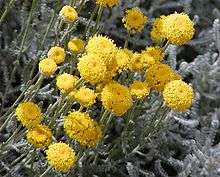Santolina chamaecyparissus
Santolina chamaecyparissus (syn. S. incana), known as cotton lavender or lavender-cotton,[4] is a species of flowering plant in the family Asteraceae, native to the western and central Mediterranean.
| Santolina chamaecyparissus | |
|---|---|
 | |
| Scientific classification | |
| Kingdom: | Plantae |
| Clade: | Tracheophytes |
| Clade: | Angiosperms |
| Clade: | Eudicots |
| Clade: | Asterids |
| Order: | Asterales |
| Family: | Asteraceae |
| Genus: | Santolina |
| Species: | S. chamaecyparissus |
| Binomial name | |
| Santolina chamaecyparissus | |
| Synonyms[1][2][3] | |
|
Santolina marchii Arrigoni | |
Nomenclature
The specific epithet chamaecyparissus means "like Chamaecyparis" (ground cypress), though it is not closely related to that plant.[5] It is also not closely related to either cotton or lavender, despite its common name "cotton lavender".
Description
It is a small, evergreen shrub growing to 50 cm (20 in) tall and broad. Densely covered in aromatic, grey-green leaves, in summer it produces masses of yellow, button-like composite flowerheads, held on slender stems above the foliage. The disc florets are tubular and there are no ray florets.[6]
Cultivation
This plant is valued in cultivation as groundcover or as an edging plant for a hot, sunny, well-drained spot, though it may be short-lived. Once established, plants can tolerate dry and poor soils. Its compact shape can be maintained by cutting back in spring. [7]
Numerous cultivars have been produced, of which 'Nana', a dwarf form growing to 25 cm (10 in), has gained the Royal Horticultural Society's Award of Garden Merit.[8]
Uses
Cotton lavender has many potential uses. Most commonly, the flowers and leaves are made into a decoction used to expel intestinal parasites. An oil used in perfumery can also be extracted from the plant. Branches may be hung up in wardrobes to repel insects, and leaves are also suitable for use in pot pourri and in herbal tobacco substitutes.
Pathogens
Photo gallery
 Foliage
Foliage S. chamaecyparissus 'Lime Fizz'
S. chamaecyparissus 'Lime Fizz'- In the UBC Botanical Garden
References
- "Santolina chamaecyparissus". International Plant Names Index (IPNI). Royal Botanic Gardens, Kew. Retrieved 2008-06-27.
- UniProt. "Species Santolina chamaecyparissus". Retrieved 2008-06-27.
- Botanic Garden and Botanical Museum Berlin-Dahlem. "Details for: Santolina chamaecyparissus". Euro+Med PlantBase. Free University of Berlin. Retrieved 2008-06-27.
- "BSBI List 2007". Botanical Society of Britain and Ireland. Archived from the original (xls) on 2015-01-25. Retrieved 2014-10-17.
- Harrison, Lorraine (2012). RHS Latin for gardeners. United Kingdom: Mitchell Beazley. p. 224. ISBN 9781845337315.
- RHS A-Z encyclopedia of garden plants. United Kingdom: Dorling Kindersley. 2008. p. 1136. ISBN 1405332964.
- "Santolina chamaecyparissus - Plant Finder". www.missouribotanicalgarden.org. Retrieved 2018-07-03.
- "RHS Plant Selector - Santolina chamaecyparissus 'Nana'". Retrieved 2 June 2013.
- Carrasco, F. (2009). "Ingredientes Cosméticos". Diccionario de Ingredientes\ 4ª Ed. www.imagenpersonal.net. p. 509. ISBN 978-84-613-4979-1.
- Álvarez, L. A.; Pérez-Sierra, A.; León, M.; Armengol, J.; García-Jiménez, J. "Lavender cotton root rot: a new host of Phytophthora tentaculata found in Spain". American Phytopathological Society. Cite journal requires
|journal=(help)